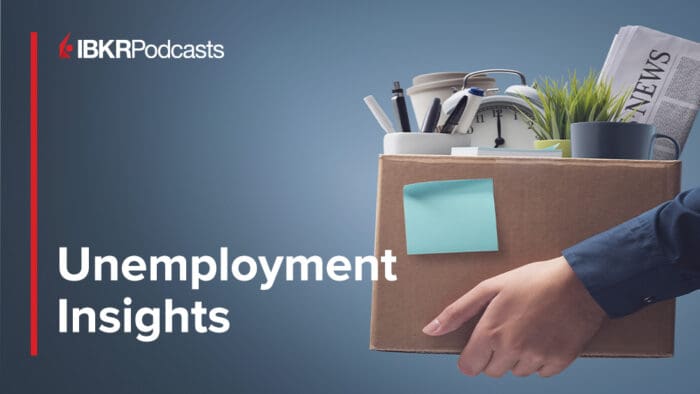Michael Normyle – Nasdaq’s US Economist joins IBKR’s Jeff Praissman to discuss the current unemployment rate and what it means for the overall US economy.
Summary – IBKR Podcasts Ep. 184
The following is a summary of a live audio recording and may contain errors in spelling or grammar. Although IBKR has edited for clarity no material changes have been made.
Jeff Praissman
Hi everyone. My name is Jeff Praissman. I’m with Interactive Brokers Podcast. It’s my pleasure to welcome back to the show Nasdaq’s U. S. Economist, Michael Normyle. Hi Michael. How are you?
Michael Normyle
Doing great. Thanks. Thanks for having me back.
Jeff Praissman
It’s my pleasure. I love doing our monthly podcast together on the economy and for today’s subject we’re going to discuss the unemployment rate.
So, Michael, what’s actually going on with the unemployment rate? It rose to 4.3% and it’s triggering the Sahm Rule?
Michael Normyle
Yeah. I mean, it drew a lot of market attention early in August. And like you said, that’s because it rose to 4.3%. And it’s been trending up for more than a year, rising from a low of 3.4 % back in April of last year. It’s a 4.3 % in the July data print that we just got.
And even though 4.3% is actually pretty low by historical standards, it caused that market sell off because like you said, it triggered a past recession indicator, the so called Sahm Rule.
Jeff Praissman
And we’ll get more into the Sahm Rule in a minute.
Are there different groups of unemployed people? Or is it all kind of considered the same for data?
Michael Normyle
Yeah, there’s a few different categories. So you can be a new entrant or a re-entrant from outside the labor force. You can quit your job, which is also a job leaver. Or you can be a job loser, either being permanently laid off, temporarily laid off, or simply just having completed a temp job.
Jeff Praissman
So, are all three of these levels or groups, are they experiencing the same level of unemployment increases or are they varying between the different groups?
Michael Normyle
Yeah, actually, in July, they pretty much are, and that’s kind of the problem. So, just to understand how the unemployment rate works, it’s the number of unemployed people divided by the number of people in the labor force. And that’s just unemployed plus unemployed people.
So the unemployment rate, it can go up because people are getting laid off where you’re flowing from being employed to unemployed, but it can also increase if people are joining the labor force where they flow from being out of the labor force and not part of the unemployment calculation at all to being in the labor force as an unemployed worker.
And if that’s happening faster than businesses are hiring, then the unemployment rate will rise. And lately, we’ve seen more of the latter than usual where it’s people coming into the labor force, and in part this is because of the strong immigration that we saw in the post COVID period and things like the rise of remote work enabling more disabled people to join the workforce along with some other factors.
But if you break down the change in the unemployment rate from its low back early last year, only about a third of it is people being permanently laid off. Another third is temporary layoffs, and the rest is people joining the labor force.
Jeff Praissman
So, I mean, in a way, some potential good news is that more people are willing and able to work in a way, if you look at it, at least in that one sector. And also opportunities arising for some people who historically couldn’t have worked in the past.
I’d like to circle back though, ‘cause we kind of started off the podcast with the Sahm Rule and it’s not exactly a household word if you’re not an economist, right? So, could you spend a few minutes and just kind of explain the Sahm Rule to our listeners?
Michael Normyle
Sure, so the Sahm Rule, it’s a recession pattern that was identified by Claudia Sahm. She’s a former Federal Reserve Staff Economist. And the point of the Sahm Rule, it’s not really to predict recessions necessarily, but to quickly identify when the economy was in recession to automatically trigger social welfare programs like enhanced unemployment benefits or stimulus checks. Things that we saw during the COVID recession and the Great Recession, instead of waiting for congressional action, which can take a while for people to recognize that the economy is in kind of a bad enough state to need that sort of additional stimulus.
And so this would be sort of an automatic way to do it. And so the way it’s calculated is by looking at the three-month moving average of the unemployment rate, and that’s done just to smooth out monthly noise. And it compares that to its low point over the previous year, again, using that three-month moving average.
And so when the difference between these two reaches at least half a percentage point, then the economy has typically been in recession. And so right now, what we saw, the unemployment rate, like we said earlier, it’s up to 4.3%.
The average over the last three months is 4.1%, but that low over the previous year is 3.6%. So that’s how we hit that 0. 5 percentage point threshold, which has historically indicated recession. It’s also worth noting that the Sahm Rule doesn’t have a perfect track record. If you look at the real time Sahm Rule indicator, which you can get from the St. Louis Fed (FRED) database, that uses the initial data releases, meaning it’s not looking at revised data, it’s looking at what was available at the time.
There was a false alarm back in the mid 70s too.
Jeff Praissman
Well, it’s interesting, too, though, to note that there are several economists out there, actually including Claudia Sahm, who introduced this indicator that are arguing that, potentially the Sahm Rule doesn’t necessarily apply this time. Why could it be wrong this time?
Michael Normyle
Yeah, so like we talked about earlier, the unemployment rate right now, it’s rising partly because of people joining the labor force, and more recently some temporary layoffs, which isn’t historically what you see around recessions. Typically that’s where you do see those kinds of permanent layoffs happening.
But there are other reasons to be cautious too. So if you look at layoffs, both actual and planned layoffs are really low. So the BLS has a data series called JOLTS data. Job openings and labor turnover, and there’s a layoff rate in there. And right now that’s tied for its lowest rate in its twenty three-year history.
So, at a record low already right now. So people just really aren’t getting laid off at a high rate, actually historically low rate currently. And then if you look at data from Challenger, Gray and Christmas, they track layoff announcements and they reported 25,000 in July, which ranks in the bottom 10% of months going back to 1993.
So actual layoffs and planned layoffs are both really low. Another piece is that we’re getting different messages from the employment data used for the unemployment rate and for non-farm payrolls.
So, when the official jobs data comes out each month from the Bureau of Labor Statistics, the unemployment rate is from a survey of households, while the headline jobs numbers is from a survey of businesses.
And so those two surveys both calculate employment numbers. But they have different methodologies and definitions. And so there’s actually an adjusted version of the household survey to make it mirror the survey of businesses. And if you look at those, the household one is actually showing that the economy has been losing 12, 000 jobs per month on average over the last year.
The survey of businesses, though, shows the economy has been adding over 200, 000 jobs per month on average. So these are completely conflicting messages, but it’s important to note that the sample size of the survey of businesses is twice that of the survey of households, which should make it the more reliable series.
So, the employment piece going into the unemployment calculation right now could be introducing a little bit of noise too.
Jeff Praissman
So, I want to kind of take both sides of this now. So, like, let’s just say if, in fact, the Sahm Rule applies in this case, what actions, if any, should the Fed take?
Michael Normyle
Yeah, I think it’s pretty easy, right? They should be cutting rates and do it fast to support the economy that’s entering a recession.
And the quicker and the sharper that they’re cutting rates, the sooner the economy will see expansionary monetary policy that’s supporting the economy instead of restrictive monetary policy that’s slowing the economy. And so right now we have that restrictive policy in place.
Jeff Praissman
And let’s just say it doesn’t apply. Should the Fed raise rates, leave them the same? Obviously, they’re not going to cut them, but..
Michael Normyle
Yeah, I mean, this is just personal opinion and I actually do think they probably should still be cutting rates because it’s clear that the economy has slowed. The unemployment rate is still rising. That’s never a good thing in most cases, right? We are seeing that some of it is driven by people getting laid off.
Not a lot of it, but some of it. So the labor market, it’s been trending down from a very strong labor market to a still pretty strong, but weaker. So it’s trending the wrong direction essentially. And so we want to avoid a situation where a vicious cycle takes hold where people are afraid of losing their jobs. So they pull back on spending. That hurts businesses revenues. So those businesses then lay people off resulting in lower spending and on and on.
Jeff Praissman
I know you kind of spoke on your thoughts right there, but any other thoughts on the current state of the economy and whether the Sahm Rule does apply, in your opinion?
Michael Normyle
Yeah, I mean, I’m personally in the same boat as Claudia Sahm, where I think there’s some reasons to be skeptical about the Sahm Rule triggering. And if it actually means that we’re in recession currently. But I don’t want to completely dismiss the message from it either, because like I said, we’ve seen some weakening in the labor market, but it has been from historically strong levels.
And we’ve seen signs that consumers are starting to feel the pinch from higher rates too. If you look at things like delinquency rates have been rising for credit cards and auto loans and that kind of stuff impacts spending.
So the economy has been slowing down and we want to prevent that from gaining speed and turning into a recession.
Jeff Praissman
Michael, as always, this has been great. Thank you so much for coming by the IBKR studio. It’s always a pleasure to have you here.
For our listeners, to find more from Michael and Nasdaq, and our podcast, just go to our website, click on Education, go to the IBKR Campus and look for Podcasts.
You can actually search by contributor as well.
It’s available on our website, on YouTube, on Apple Music, Spotify, Amazon Music, the usual places. And look forward to having you back in the studio next month. Thanks again, Michael.
Michael Normyle
Thanks.
Disclosure: Nasdaq
Index
Nasdaq® is a registered trademark of Nasdaq, Inc. The information contained above is provided for informational and educational purposes only, and nothing contained herein should be construed as investment advice, either on behalf of a particular security or an overall investment strategy. Neither Nasdaq, Inc. nor any of its affiliates makes any recommendation to buy or sell any security or any representation about the financial condition of any company. Statements regarding Nasdaq-listed companies or Nasdaq proprietary indexes are not guarantees of future performance. Actual results may differ materially from those expressed or implied. Past performance is not indicative of future results. Investors should undertake their own due diligence and carefully evaluate companies before investing. ADVICE FROM A SECURITIES PROFESSIONAL IS STRONGLY ADVISED.
© 2023. Nasdaq, Inc. All Rights Reserved.
Options
For the sake of simplicity, the examples included do not take into consideration commissions and other transaction fees, tax considerations, or margin requirements, which are factors that may significantly affect the economic consequences of a given strategy. An investor should review transaction costs, margin requirements and tax considerations with a broker and tax advisor before entering into any options strategy.
Options involve risk and are not suitable for everyone. Prior to buying or selling an option, a person must receive a copy of Characteristics and Risks of Standardized Options. Copies may be obtained from your broker, one of the exchanges or The Options Clearing Corporation, One North Wacker Drive, Suite 500, Chicago, IL 60606 or call 1-888-OPTIONS or visit www.888options.com.
Any strategies discussed, including examples using actual securities and price data, are strictly for illustrative and education purposes and are not to be construed as an endorsement, recommendation or solicitation to buy or sell securities.
© 2023. Nasdaq, Inc. All Rights Reserved.
Disclosure: Interactive Brokers
Information posted on IBKR Campus that is provided by third-parties does NOT constitute a recommendation that you should contract for the services of that third party. Third-party participants who contribute to IBKR Campus are independent of Interactive Brokers and Interactive Brokers does not make any representations or warranties concerning the services offered, their past or future performance, or the accuracy of the information provided by the third party. Past performance is no guarantee of future results.
This material is from Nasdaq and is being posted with its permission. The views expressed in this material are solely those of the author and/or Nasdaq and Interactive Brokers is not endorsing or recommending any investment or trading discussed in the material. This material is not and should not be construed as an offer to buy or sell any security. It should not be construed as research or investment advice or a recommendation to buy, sell or hold any security or commodity. This material does not and is not intended to take into account the particular financial conditions, investment objectives or requirements of individual customers. Before acting on this material, you should consider whether it is suitable for your particular circumstances and, as necessary, seek professional advice.



















Join The Conversation
If you have a general question, it may already be covered in our FAQs. If you have an account-specific question or concern, please reach out to Client Services.